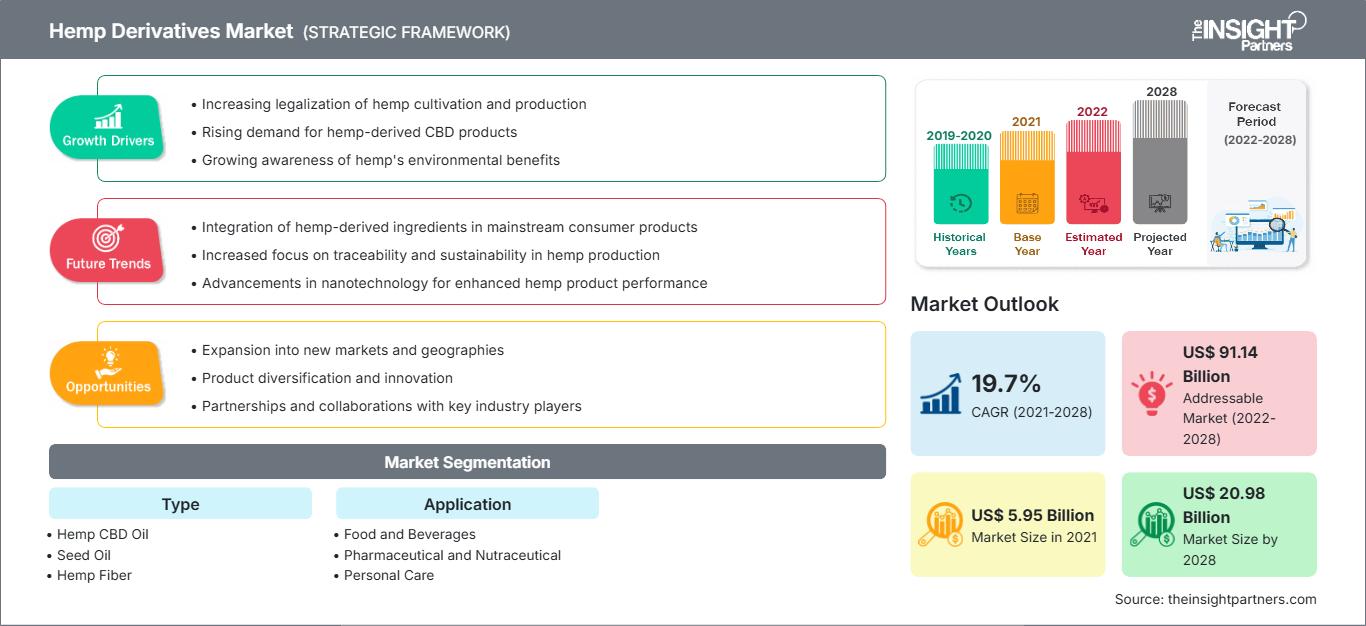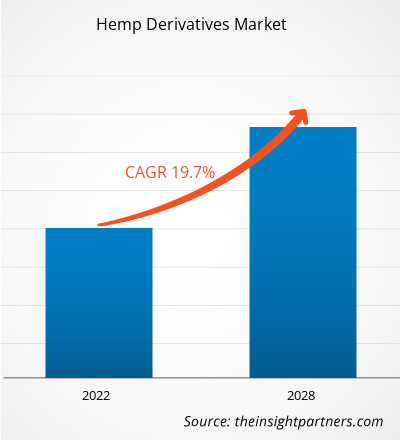Le marché des dérivés du chanvre était évalué à 5 953,86 millions de dollars américains en 2021 et devrait atteindre 20 977,94 millions de dollars américains d'ici 2028 ; il devrait croître à un TCAC de 19,7 % entre 2021 et 2028.
Le chanvre, ou chanvre industriel, est une variété de plante de cannabis sativa, cultivée spécifiquement pour un usage industriel. Les dérivés du chanvre, tels que le CBD, l'huile de graines et les fibres, sont dérivés du chanvre et ont diverses applications dans plusieurs industries d'utilisation finale, telles que l'alimentation et les boissons, les produits pharmaceutiques, les soins personnels et l'alimentation animale.
En 2021, l'Asie-Pacifique représentait la plus grande part du marché mondial des dérivés du chanvre. La sensibilisation croissante aux bienfaits médicaux des dérivés du chanvre accroît leur utilisation dans la région. Parallèlement, les dérivés du chanvre trouvent plusieurs applications dans l'industrie textile. De plus, l'essor du marché des cosmétiques et des produits de soins personnels en Asie-Pacifique et la légalisation du chanvre industriel dans les compléments alimentaires devraient stimuler le marché dans la région au cours de la période de prévision.
La pandémie de COVID-19 a eu un impact relativement positif sur le marché des dérivés du chanvre. Elle a contribué à développer la sensibilisation et l'intérêt pour le secteur médical du chanvre. La crise a été une période désagréable et stressante pour la majeure partie de la population mondiale. Par conséquent, des personnes du monde entier ont commencé à consommer des produits dérivés du chanvre pour traiter leur anxiété et leur stress. Plusieurs utilisateurs importants ont augmenté leur consommation. La consommation pour les troubles du sommeil et la dépression est également excessive. En raison de l'attention accrue portée à la santé et au bien-être pendant la pandémie, les recherches sur Google concernant les bienfaits des dérivés du chanvre pour la santé ont augmenté, ce qui a accru la sensibilisation à ces produits. Parallèlement, de nombreux pays ont été touchés par des déficits fiscaux liés à la pandémie. Les gouvernements cherchent des sources de recettes fiscales. La légalisation du chanvre et de ses dérivés pourrait constituer une source potentielle de croissance. Une augmentation des ventes de chanvre et de ses dérivés par les vendeurs légaux pourrait générer un gain fiscal potentiel.
Diverses recherches ont également été menées pendant la pandémie de COVID-19, axées sur l'utilisation du chanvre et de ses dérivés pour le traitement de la COVID-19. Des chercheurs canadiens ont mené une étude pour déterminer si les extraits de Cannabis sativa pouvaient contribuer à réduire les niveaux du récepteur de la cellule hôte auquel le virus SARS-CoV-2 s'accroche pour pénétrer et se propager. Parallèlement, STERO Biotech, une entreprise basée en Israël, apporte des éclairages sur l'utilisation du cannabis et du CBD comme traitement potentiel de la COVID-19. Ainsi, diverses recherches sur le chanvre et ses dérivés visant à déterminer leur utilisation dans le traitement de la COVID-19 ont un impact positif sur le marché des dérivés du chanvre.
Personnalisez ce rapport en fonction de vos besoins
Vous bénéficierez d’une personnalisation sur n’importe quel rapport - gratuitement - y compris des parties de ce rapport, ou une analyse au niveau du pays, un pack de données Excel, ainsi que de profiter d’offres exceptionnelles et de réductions pour les start-ups et les universités
Marché des dérivés du chanvre: Perspectives stratégiques

-
Obtenez les principales tendances clés du marché de ce rapport.Cet échantillon GRATUIT comprendra une analyse de données, allant des tendances du marché aux estimations et prévisions.
Le chanvre est de plus en plus utilisé pour diverses applications dans différents secteurs. Les graines et le tourteau de chanvre sont utilisés comme source alternative de protéines pour l'alimentation humaine et animale dans l'industrie agroalimentaire. De plus, l'huile obtenue par broyage des graines de chanvre est utilisée dans la fabrication de savons, de shampoings, de lotions, de cosmétiques et de gels de bain. Riche en acides aminés, minéraux et vitamines, l'huile obtenue à partir des graines de chanvre est utilisée dans les compléments alimentaires ainsi que dans les produits médicinaux et thérapeutiques. Les fibres obtenues à partir du chanvre contiennent une grande quantité d'hémicellulose et une grande capacité d'absorption, ce qui en fait une culture idéale pour l'industrie textile. Les tiges et les fibres de chanvre sont utilisées pour la fabrication de vêtements, de papier, de matériaux de construction, de plastique et de composites, entre autres. La fibre de chanvre est également utilisée dans la fabrication de matériaux isolants et de biocomposites en raison de sa grande résistance, de sa biodégradabilité, de ses propriétés thermodynamiques et de sa légèreté. Les fibres de chanvre sont utilisées dans le secteur de la construction pour la fabrication de matériaux tels que les panneaux de fibres, le stuc et le mortier, les blocs de ciment, les revêtements, les matériaux acoustiques et les gaines de tuyaux. Les composites, utilisés dans la fabrication de produits à base de pétrole, sont également fabriqués à partir de chanvre. Les graines de chanvre sont riches en nutriments et en protéines et peuvent remplacer le soja. Grâce à leur teneur en protéines, les graines de chanvre sont utilisées dans la production de produits à base de soja, notamment le tofu, le beurre, le fromage, les hamburgers, les glaces et le lait. Ainsi, l'utilisation croissante des dérivés du chanvre dans diverses industries a entraîné une hausse de la demande, stimulant ainsi le marché des dérivés du chanvre.
Informations sur les types
Le marché des dérivés du chanvre est segmenté selon le type : huile de CBD, huile de graines, fibre de chanvre, etc. En 2021, le segment des fibres de chanvre détenait la plus grande part de marché. Le chanvre est une plante à fibres libériennes comme le jute, le kénaf et le lin. Ces fibres sont désormais utilisées comme renforts dans les matériaux composites en raison de leur biodégradabilité et de leur densité inférieure à celle des fibres artificielles. La fibre de chanvre conduit la chaleur, résiste à la moisissure, se teint bien, bloque les ultraviolets et possède des propriétés antibactériennes naturelles.
Parmi les principaux acteurs du marché des dérivés du chanvre, on trouve : Colorado Hemp Works, Inc ; Dun Agro Hemp Group ; Ecofiber ; Hempflax Group BV ; Hempoland Sp. Z OO ; Konoplex, Mh Medical Hemp Gmbh ; Plains Industrial Hemp Processing Ltd ; South Hemp ; et BAFA Neu GmbH. Les principaux acteurs du marché adoptent des stratégies telles que les fusions-acquisitions et les lancements de produits pour étendre leur présence géographique et leur clientèle.
Points forts du rapport
- Tendances progressives dans l'industrie des dérivés du chanvre pour aider les acteurs à développer des stratégies efficaces à long terme
- Stratégies de croissance commerciale adoptées par les entreprises pour assurer la croissance sur les marchés développés et en développement
- Analyse quantitative du marché mondial des dérivés du chanvre de 2019 à 2028
- Estimation de la demande de dérivés du chanvre dans divers secteurs
- Analyse de Porter pour illustrer l'efficacité des acheteurs et des fournisseurs opérant dans l'industrie pour prédire la croissance du marché
- Évolutions récentes pour comprendre le scénario de marché concurrentiel et la demande de dérivés du chanvre
- Tendances et perspectives du marché associées aux facteurs qui stimulent et freinent la croissance du marché des dérivés du chanvre
- Compréhension des stratégies qui sous-tendent l'intérêt commercial concernant la croissance du marché mondial des dérivés du chanvre, aidant au processus de prise de décision
- Taille du marché des dérivés du chanvre à différents nœuds du marché
- Aperçu détaillé et segmentation du marché mondial des dérivés du chanvre ainsi que sa dynamique industrielle
- Taille du marché des dérivés du chanvre dans diverses régions avec des opportunités de croissance prometteuses
Les tendances régionales et les facteurs influençant le marché des dérivés du chanvre tout au long de la période de prévision ont été analysés en détail par les analystes de The Insight Partners. Cette section aborde également les segments et la géographie du marché des dérivés du chanvre en Amérique du Nord, en Europe, en Asie-Pacifique, au Moyen-Orient et en Afrique, ainsi qu'en Amérique du Sud et en Amérique centrale.
Portée du rapport sur le marché des dérivés du chanvre| Attribut de rapport | Détails |
|---|---|
| Taille du marché en 2021 | US$ 5.95 Billion |
| Taille du marché par 2028 | US$ 20.98 Billion |
| TCAC mondial (2021 - 2028) | 19.7% |
| Données historiques | 2019-2020 |
| Période de prévision | 2022-2028 |
| Segments couverts |
By Type
|
| Régions et pays couverts |
Amérique du Nord
|
| Leaders du marché et profils d'entreprises clés |
|
Densité des acteurs du marché des dérivés du chanvre : comprendre son impact sur la dynamique commerciale
Le marché des dérivés du chanvre connaît une croissance rapide, porté par une demande croissante des utilisateurs finaux, due à des facteurs tels que l'évolution des préférences des consommateurs, les avancées technologiques et une meilleure connaissance des avantages du produit. Face à cette demande croissante, les entreprises élargissent leur offre, innovent pour répondre aux besoins des consommateurs et capitalisent sur les nouvelles tendances, ce qui alimente la croissance du marché.
- Obtenez le Marché des dérivés du chanvre Aperçu des principaux acteurs clés
- Huile de CBD de chanvre
- Huile de graines
- Fibre de chanvre
- Autres
Marché des dérivés du chanvre, par application
- Aliments et boissons
- Produits pharmaceutiques et nutraceutiques
- Soins personnels
- Textiles
- Autres
Profils d'entreprise
- Colorado Hemp Works, Inc
- Dun Agro Hemp Group
- Ecofiber
- Hempflax Group BV
- Hempoland Sp. Z OO
- Konoplex
- Mh Medical Hemp Gmbh
- Plains Industrial Hemp Processing Ltd
- Chanvre du Sud
- BAFA Neu GmbH
- Analyse historique (2 ans), année de base, prévision (7 ans) avec TCAC
- Analyse PEST et SWOT
- Taille du marché Valeur / Volume - Mondial, Régional, Pays
- Industrie et paysage concurrentiel
- Ensemble de données Excel
Rapports récents
Témoignages
Raison d'acheter
- Prise de décision éclairée
- Compréhension de la dynamique du marché
- Analyse concurrentielle
- Connaissances clients
- Prévisions de marché
- Atténuation des risques
- Planification stratégique
- Justification des investissements
- Identification des marchés émergents
- Amélioration des stratégies marketing
- Amélioration de l'efficacité opérationnelle
- Alignement sur les tendances réglementaires






















 Obtenez un échantillon gratuit pour - Marché des dérivés du chanvre
Obtenez un échantillon gratuit pour - Marché des dérivés du chanvre